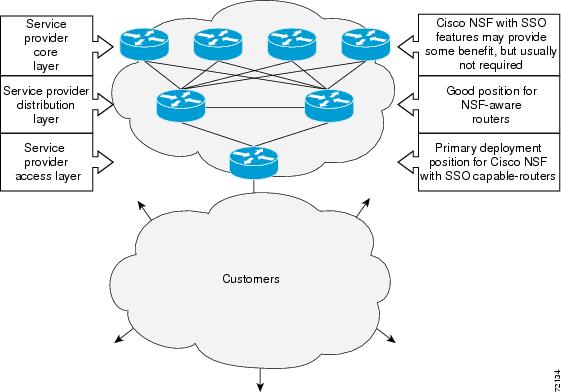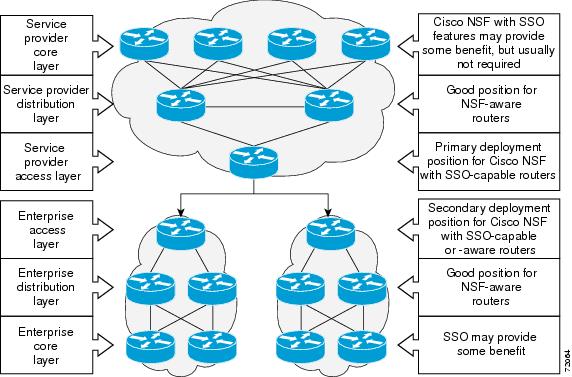|
Stateful Switchover (SSO)
|
12.0(22)S 12.0(23)S 12.0(24)S 12.2(20)S 12.2(18)S 12.2(33)SRA
|
This feature was introduced:
In 12.0(23)S, support was added for 1xGE and 3xGE line cards on the Cisco 12000 series Internet router.
In 12.0(24)S, support was added for the following line cards on the Cisco 12000 series Internet router:
-
-
Engine 2
- 1-port OC-48/STM-16c DPT
- 8-port OC-3/STM-1c ATM
-
IP Service Engine (ISE)
- 4-port OC-3c/STM-1c POS/SDH ISE
- 8-port OC-3c/STM-1c POS/SDH ISE
- 16-port OC-3c/STM-1c POS/SDH ISE
- 4-port OC-12c/STM-4c POS/SDH ISE
- 1-port OC-48c/STM-16c POS/SDH ISE
- 4-port channelized OC-12/STM-4 (DS3/E3, OC-3c/STM-1c) POS/SDH ISE
- 1-port channelized OC-48/STM-16 (DS3/E3, OC-3c/STM-1c) POS/SDH ISE
In 12.0(26)S, support was added for the following line cards on the Cisco 12000 series Internet router:
In 12.2(20)S, support was added for the Cisco 7304 router.
|
|
CEM SSO/ISSU
|
12.2(33)SRC
|
This feature was introduced.
|
|
Dynamic Host Configuration Protocol (DHCP) On Demand Address Pool (ODAP) client/server
|
12.2(31)SB2
|
This feature was updated to be SSO-compliant.
|
|
NSF/SSO--Virtual Private LAN Services
|
12.2(33)SXI4 15.0(1)S
|
This feature was introduced.
|
|
Route Processor Redundancy Plus (RPR+)
|
12.2(20)S
|
This feature was introduced on the Cisco 7304 router.
|
|
SSO - Automatic Protection Switching (APS)
|
12.2(28)SB
|
This feature was introduced.
|
|
SSO - BFD (Admin Down)
|
12.2(33)SB
|
This feature was introduced.
|
|
SSO - DHCP proxy client
|
12.2(31)SB2 12.2(33)SRC
|
This feature was updated to be SSO-compliant.
In 12.2(33)SRC, this feature was introduced.
|
|
SSO - DHCP relay on unnumbered interface
|
12.2(31)SB2
|
This feature was updated to be SSO-compliant.
|
|
SSO - DHCP server
|
12.2(31)SB2
|
This feature was updated to be SSO-compliant.
|
|
SSO - Gateway Load Balancing Protocol (GLBP)
|
12.2(31)SB2 12.2(33)SXH
|
This feature was updated to be SSO-compliant.
|
|
SSO - HDLC
|
12.2(28)SB 15.0(1)S
|
This feature was introduced.
|
|
SSO - HSRP
|
12.2(33)SXH 15.0(1)S Cisco IOS XE 3.1.0SG
|
This feature was introduced.
|
|
SSO - MLPPP
|
12.2(28)SB
|
This feature was introduced.
|
|
SSO - Multilink Frame Relay
|
12.2(25)S 12.2(31)SB2 12.2(33)SRB 15.0(1)S
|
This feature was introduced.
In 12.2(28)S, support was added for the Cisco 12000 series Internet router.
In 12.2(31)SB2, support was added for the Cisco 10000 series Internet router.
In 12.2(33)SRB, this feature was updated to be SSO compliant.
|
|
SSO - Multilink PPP (MLP)
|
15.0(1)S
|
This feature is supported.
|
|
SSO - PPP
|
12.2(33)SRB 15.0(1)S
|
This feature was updated to be SSO-compliant.
|
|
SSO - PPPoA
|
12.2(31)SB2
|
This feature was updated to be SSO-compliant.
|
|
SSO - PPPoE
|
12.2(31)SB2
|
This feature was updated to be SSO-compliant.
|
|
SSO - PPPoE IPv6
|
12.2(33)SXE
|
This feature was introduced.
|
|
SSO - Quality of Service (QoS)
|
12.2(25)S 15.0(1)S
|
This feature was introduced.
|
|
SSO - VRRP
|
12.2(33)SRC 15.0(1)S
|
This feature was introduced.
|
|
Virtual template manager SSO
|
12.2(33)SRC
|
This feature was introduced.
|




 Feedback
Feedback